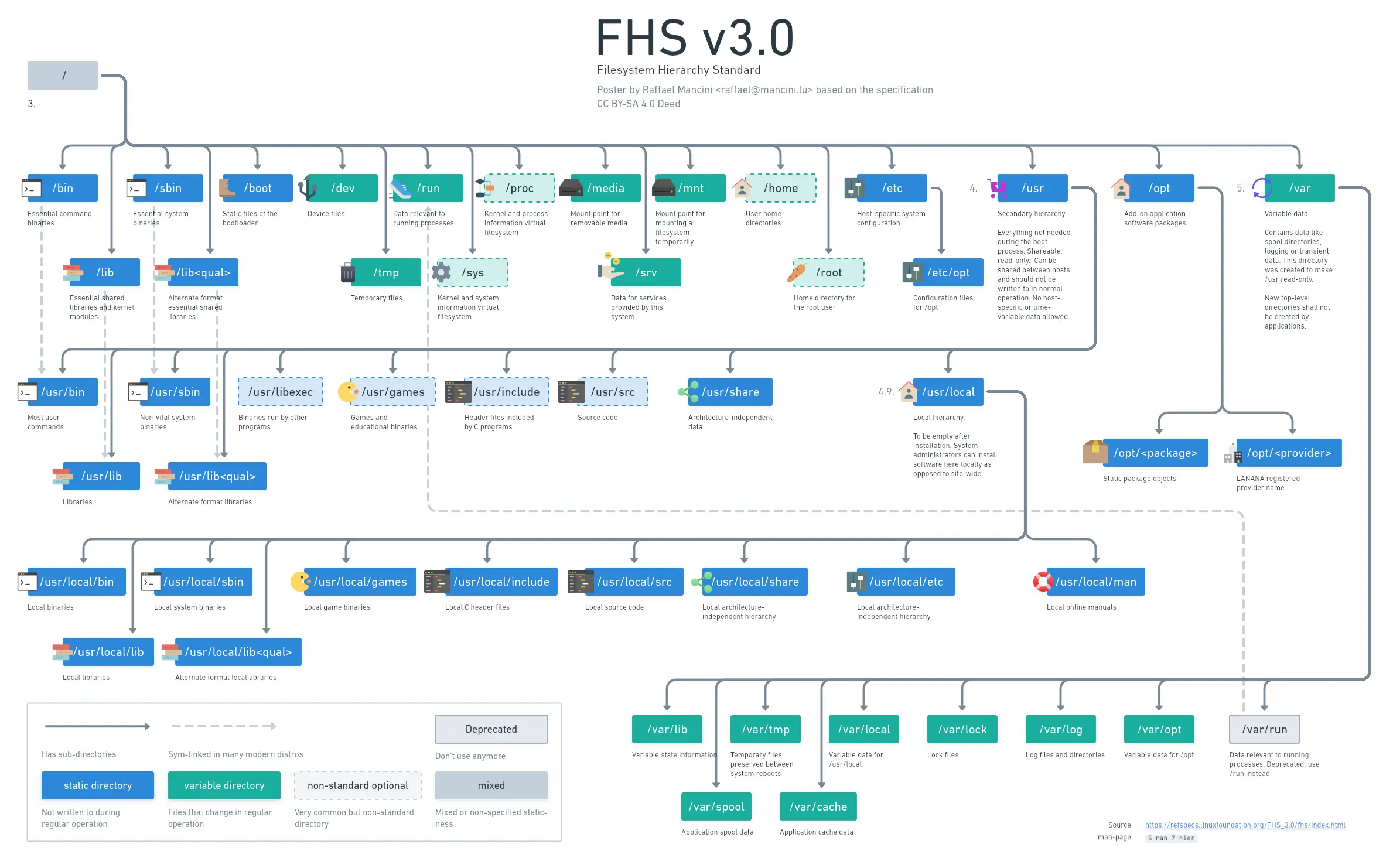- cross-posted to:
- coolguides
- cross-posted to:
- coolguides
i always thought /usr stood for “user”. Please tell me I’m not the only one
Ken Thompson and Dennis Ritchie created Unix on a PDP-7 in 1969. Well around 1971 they upgraded to a PDP-11 with a pair of RK05 disk packs (1.5 megabytes each) for storage.
When the operating system grew too big to fit on the first RK05 disk pack (their root filesystem) they let it leak into the second one, which is where all the user home directories lived (which is why the mount was called /usr). They replicated all the OS directories under there (/bin, /sbin, /lib, /tmp…) and wrote files to those new directories because their original disk was out of space. When they got a third disk, they mounted it on /home and relocated all the user directories to there so the OS could consume all the space on both disks and grow to THREE WHOLE MEGABYTES. And thereafter /usr is used to store user programs while /home is used to store user data.
source: http://lists.busybox.net/pipermail/busybox/2010-December/074114.html
Removed by mod
Same, but with a 22TB drive for /data loooool
This thread is 3 MB
You’re not the only one 😅 🙋
I thought it was United System Resources.
And I still don’t know what’s the point in separating /bin, /sbin, /usr/bin and /usr/sbin.
Also /mnt and /media
Or why it’s /root and not /home/rootMostly historical reasons, /home was often a network mounted directory, but /root must be local.
And only regular users have their home in /home
Idk why I feel compelled to add this info, but / doesn’t have to be local as long as the necessary kernel modules for mounting it are available in the initrd or built into the kernel.
Yes, that is true. I was speaking in the context of very early Unix/Linux before initrd was a thing.
/home is often on a separate volume. You’d want root to be available in a maintenance situation where /home may not be mounted.
I don’t recall the reasons for the addition but /media is newer than /mnt.
I don’t recall the reasons for the addition but /media is newer than /mnt.
Something to do with hard-coded mounts in
/etc/fstabvs. dynamically-mounted removable media (USB drives etc.), I think.I’ve also seen autofs network automounts go in /net
And I still don’t know what’s the point in separating /bin, /sbin, /usr/bin and /usr/sbin.
This goes back to the olden days when disk space was measured in kilo and megabytes. /sbin/ and /usr/sbin have the files needed to start a bare bone Unix/Linux system, so that you could boot from a 800kb floppy and mount all other directories via network or other storage devices as needed.
Is there a reason to keep this structure other than „we’ve always been doing it like that“/backwards compatibility?
The structure is changing, many distributions already are merging more and more of the duplicated subdirectories in /usr/ with the counterparts in / but it takes time to complete that and at the moment those subdirectories are often still there but as symlinks to be compatible with older software (and sysadmins).
They hold “system binaries” meant for root user. It’s not a hard distinction but many if not most Linux fundamentals have their roots in very early computing, mainframes, Bell and Xerox, and this good idea has been carried into the here&now. Not sure about the provenance of this one, but it makes sense. isn’t /mnt /media different between distros? These aren’t hard and fast rules - some distros choose to keep files elsewhere from the “standard”.
/bin and /usr/bin, one is typically a symbolic link to another - they used to be stored on disks of different size, cost, and speed.
https://refspecs.linuxfoundation.org/FHS_3.0/fhs/ch03s16.html
https://unix.stackexchange.com/questions/5915/difference-between-bin-and-usr-bin
I think /mnt is where you manually mount a hard drive or other device if you’re just doing it temporarily, and /media has sub folders for stuff like cdrom drives or thumb drives?
Yeah, but why?
You can mount a hard drive anywhere, and why not put all the cdrom and thumbdrive folders in /mnt, too?/media is for removable drives. If you mount something there, file managers like Gnome will show you the “eject” or “disconnect” button.
/mnt drives show up as regular network drives without that “eject” functionality.
I don’t know if I’m doing something wrong, but I have a secondary SSD in my laptop that I mount on
/mnt/elyssaand in every DE and distro I tried it appeared as a removable drive with the “eject” button. Right now I use Fedora with Gnome and if I install this extension or enable the removable drives option in Dash to Dock, it shows me that drive. Maybe some mount option in Gnome Disks, but since it’s not that big of a problem, I haven’t looked too much into it.
It gets even more complicated nowadays because most DE will mount removable drives somewhere in folders like /run/$USER/
/mnt is meant for volumes that you manually mount temporarily. This used to be basically the only way to use removable media back in the day.
/media came to be when the automatic mounting of removable media became a fashionable thing.
And it’s kind of the same to this day. /media is understood to be managed by automounters and /mnt is what you’re supposed to mess with as a user.
/sbin are system binaries, eg root only stuff, dunno the rest but I would guess there are some historical reasons for the bin usr/bin separation
I know the distinction between /bin and /sbin, I just don’t know what purpose it serves.
Historically, /bin contained binaries that were needed before /usr was mounted during the boot process (/usr was usually on a networked drive).
Nowadays that’s obsolete, and most distros go ahead and merge the directories.It’s easier to manage security that way.
Instead of having one binary folder full of stuff that’s intended to be run with privilege access and non-privilege access, all the privileged stuff goes in sbin and you don’t even see it in your path as a regular user. It also means that access rights can be controlled at the folder level instead of the individual file level.
I think it originally did under old Unix, it was what /home is nowadays; “Unix System Resources” is a backronym.
deleted by creator
It’s always been for USeR binaries. It’s the first time I’ve seen this bizarre backronym (40 years of Unix here).
I was just about to post the same thing. I’ve been using Linux for almost 10 years. I never really understood the folder layout anyway into this detail. My reasoning always was that /lib was more system-wide and /usr/lib was for stuff installed for me only. That never made sense though, since there is only one /usr and not one for every user. But I never really thought further, I just let it be.
Yup same. I always wondered why there was a user folder when we already have home.
Same. I actually feel like I remember the professor of my only unix class saying that. Hoping I’m wrong.
Likewise.
It’s also only just now dawning on me /bin is short for /binaries. I always thought it was like… A bin. like a junk drawer hidden in a cupboard
deleted by creator
That’s what I thought too. This is directory structure, not file systems.
Meanwhile the Linux Standards Base cries in a corner.
https://lemmy.world/post/9437525
My version of this with a bit more detail

Thanks! I’ll save this, tell myself I’m going to strictly follow it this time and forget about it (again) lol
Cool. Thanks for sharing!
Much better, thanks!
Edit: Thank you, found it on your shared link ! 😄
Oh wow thank you ! Would it be to much to ask for a dark mode version? If there’s a one hit button to change into a more eye friendly color mode :)
Either way, thank your for sharing your work :))
Look at the post behind the link. There is a dark mode version.
I still have no clue where permanently attached USB SSDs are supposed to be mounted. I just shove them into LVM2 and put the mapper under /mnt since putting them under /home wouldn’t let other users access them.
permanently attached USB SSDs are supposed to be mounted
Just mount them somewhere under
/device, so if a disk/mount fails the mounts depended on the path can´t also fail.I keep my permanent mounts at
/media/and I have a udev rule, that all auto mounted media goes there, so/mntstays empty. A funny case is that my projects BTRFS sub-volume also is mounted this way, although it is technically on the same device.
It can fits as a desktop wallpaper.
I don’t get why this sort of picture always gets posted and upvoted when it’s wrong for most distros nowadays.
Can you recommend one that is correct? I use pop_os (Ubuntu) and Arch. Kinda curious about either one
Not aware of any correct pictures, but I can tell you what’s wrong with this one
- /usr: explaining it as “Unix System Resources” is a bit vague
- /bin: /bin is usually a symlink to /usr/bin
- /sbin: /sbin is usually a symlink to /usr/sbin, distros like Fedora are also looking into merging sbin into bin
- /opt: many, I’d say most, “add-on applications” put themselves in bin
- /media: /media is usually a symlink to /run/media, also weird to mention CD-ROMs when flash drives and other forms of storage get mounted here by default
- /mnt: i would disagree about the temporary part, as I mentioned before, stuff like flash drives are usually mounted in /run/media by default
- /root: the root user is usually not enabled on home systems
- /lib: /lib is usually a symlink to /usr/lib
I would also like the mention that the FHS standard wasn’t designed to be elegant, well thought out system. It mainly documents how the filesystem has been traditionally laid out. I forget which folder(s), but once a new folder has been made just because the main hard drive in a developer’s system filled up so they created a new folder named something different on a secondary hard drive.
Thanks for this. I’m always confused by the layout and this tend to stick to putting things in the same places, even if they’re wrong :)
On my distro(Bazzite), /mnt is only a symlink to /var/mnt. Not sure why, but only found out the other day.
I’m using Silverblue and it also symlinks to /var/mnt. I don’t think it does that on traditional distros, like Fedora 40 Workstation.
I assume it is because /var can be written to while the rest of the filesystem ( outside /home ) is expected to be read-only.
See file-hierarchy(7).
It seems handy when you’re learning about stuff but only when you haven’t learned enough to realize it’s not correct.
wait /usr doesn’t mean user?
/etc has to be the worst name in there
usr does mean user. It was the place for user managed stuff originally. The home directory used to be a sub directory of the usr directory.
The meaning and purpose of unix directories has very organically evolved. Heck, it’s still evolving. For example, the new .config directory in the home directory.
For example, the new .config directory in the home directory.
I hope slowly but surely no program will ever dump its config(s) as
~/.xyz.conf(or even worse in a program specific~/.thisapp/; The~/.config/scheme works as long as the programs don’t repeat the bad way of dumping files as~/.config/thisconfig.txt. (I’m looking at you kde folks…) A unique dir in .config directory should be mandatory.If I ever need to shed some cruft accumulated over the years in ~/.config/ this would make it a lot easier.
Per the graphic, it means Unix System Resources…
I don’t trust a graphic which explains /boot as “system boot loader files”…
It kind of makes sense on many BIOS/UEFI-less systems where e.g. Uboot is used. And it does contain things like kernel images, sometimes initRD files etc. (which may not be bootloader files but are still system boot files).
Why? What’s inaccurate about it? I have no idea and would like to learn.
It’s not wrong, but it feels a bit like some tech articles you’ll see which are obviously just created to fluff up a CV. I wouldn’t say avyttring here is flat out wrong, just kinda… lacking.
But yeah, /boot holds “system boot loader files”, sure, but that’s a bit vague. It should contain your kernel and initramcpio and IIRC Grub also had its config here. That’s pretty much it. I would’ve rather said /boot contains the kernel.
“device files” it’s so vague that it’s almost wrong IMO. At first glaze I would’ve thought that it means drivers rather than, say, “interfaces to devices”
Well that’s a shame for me. This graphic finally made the Linux file directory structure make sense to me
I wonder why that isn’t /cfg? Is there a historical reason?
According to this, it’s been around since the 70’s and was originally just a catch-all for files that didn’t fit in the other default directories, but over time has come to be mostly used for config files. I assume it would cause utter mayhem to try and change the name now so I guess it just sticks. Someone suggested “Edit To Configure” as a backronym to try and make it make more sense if that helps anyone lol.
I too expected it to be “et cetera”.
Is there a historical reason?
If you’re asking that in anything Linux related, it’s probably a Yes 99% of the time LMAO
Not just Linux… 99% of the time you see something weird in the computing world, the reason is going to be “because history.”
Looks at the entire networking stack
Yup (unfortunately)
Windows 11 is still reserving A and B drive for floppy discs.
Try naming a folder “CON” in Windows and learn the magic of old spaghetti code by a multi billion dollar company.
It’s probably the standard in both POSIX and the Single UNIX Specification, so I guess ask Ken Thompson?
It meant user, as in user-installed programs and libraries for this system over the core system programs and libraries of the operating system in /bin and /lib.
Someone learned it wrong, but otherwise I think the image is right.
deleted by creator
I learned about 16 years ago on a Solaris course that /usr wasn’t “user”, I still say “user”, but I’m happy to see the information spreading that that isn’t what it actually is.
I learned that just now.
It’s going to be TOUGH to mentally replace.
Wow, what an odd coincidence.
I always thought it was user and never questioned it. Yeah man there’s shared libraries in there for all the users, so it’s user. This makes more sense now.
usr did originally mean user and held user data.
Pretty sure this is a bacronym
I used to pronounce it like yuzr, knowing that it wasn’t user, but not knowing what it was.
Now I have better context. Maybe I’ll go with U.S.R.If you want to confuse people… I pronounce /etc as “ets”, but one of my coworkers recently called it “slash e t c” and I had to ask him to repeat it a couple times before I figured out what he meant…
Well, considering that I am with coworkers who don’t remember when to and not to put the ‘/’ at the start of the file path (despite me explaining it to them multiple times), “slash e t c” is probably the better way.
/home is for every program to store its personal junk in hidden files apaprently
/opt/(app)/bin /usr/lib/(app)/bin /usr/lib64/app/bin /usr/local/(s)bin
I know there is logic and mapping of where everything’s supposed to be in theory but in practice s***'s kind of all over the place.
The logic was just that when UNIX was originally evolving, they ran out of disk space on their PDP-11 and had to start moving less-essential binaries to a different disk. That’s why it’s “/usr/” which was originally for user data but that disk happened to have free space.
Any other explanation is just retcon. Some distros try to simplify things.
A pedantic thing to say, surely, but the title really should’ve been: “Linux Directory Structure” – ‘Linux filesystems’ (the title in the graphic) refers to a different topic entirely; the title of this post mitigates the confusion a bit, though still, ‘directory structure’ is the better term.
To be more pedantic the correct title would be the Filesystem Hierarchy Standard (FHS)…which describes the directory structures
Right?
I was expecting superiors to the fat & exfat file storage systems
Sure but for example I understand that /dev and /proc are actually kind of filesystems on their own
Yep, You are right. Done
Here’s a higher quality version

Great username
I always thought /usr was for “user”… TIL
It is, this infographic is wrong. Or I guess technically some other standard could define it like the infographic, but the Filesystem Hierarchy Standard defines it as a secondary hierarchy specifically for user data.
/usr used to be the user home directory on Unix…well most of them. I think Solaris/SunOS has always been /export/home as I recall.
It did, let me explain:
On the original (ie Thompson and Ritchie at Bell in 1969-71), I think it was a PDP-11, they installed to a 512kb hard disk.
As their “stuff” grew they needed to sprawl the OS to another drive, so they mounted it under /usr and threw OS components that didn’t fit.
https://landley.net/writing/unixpaths.pdf
I’ve done the same, outgrew so you mount under a tree to keep going, it just never became a historical artifact.
Huh. I did as well. Like /use/bin was for user installed applications and such. You learn something everyday.
A good first approximation.
So where in this setup would you mount a network share? Or am additional hard drive for storage? The latter is neither removable nor temporary. Also
/runis quite more than what this makes it seem (e.g. user mounts can be located there), there is practically only one system path for executables (/usr/bin)…Not saying that the graphic is inherently wrong or bad, but one shouldn’t think it’s the end all be all.
I do /volumX for additional hard drives.
For most network share I use /mnt/$server.
For most network share I use /mnt/$server.
I use
/mnt/$proto/$server, though that level of organization was probably overkill. Whatever…I do /volumX for additional hard drives.

Or /home/me/drive
I’m gonna blow everyone’s mind… I have my Linux system in a relatively small 4gb drive, and my home in a 4Tb drive. I mount my 4tb drive to /home/me as someone already said.
If my SSD for my OS takes a shit as people say, all you do is install it again, change fstab to swap the home directory and you’re back in business like nothing happened. That’s like 10 minutes install time on a good SSD these days. The other guy who mentioned this, didn’t point this out. The idea of separating my home folder into its own drive didn’t occur to me for years and years of using Linux. Every wrong update I was there copying home like a total windows 11 noob. I also install my extra drives and shares on /mnt, that’s standard.
On debian when i mount an ftp server through my file browser it uses gvfs
This will mount it to /run/user/1000/gvfs/ftp:host=<IP>,port=<PORT>,user=<fpt-user>
I never understood the title for /usr. Now I do. Thanks!
It’s just short for “user;” “User System Resources” is probably a backronym.
I always thought it stood for user. I even say it that way.
This email explains it in detail: http://lists.busybox.net/pipermail/busybox/2010-December/074114.html
TLDR:
/usrstands foruserThat’s what I’d always thought. Thanks for correcting the bad info from the image. I’d hate to carry that bad info forward.
Those are directories, not filesystems.
It feels like
/opt's official meaning is completely lost on developers/packagers (depending on who’s at fault), every single directory in my/optbelongs to standalone software that should just be put into either/usr/libor/usr/sharewith some symlinks or scripts into/usr/bin.I’ve also seen creating there deployment or configuration stack of your choice.
































